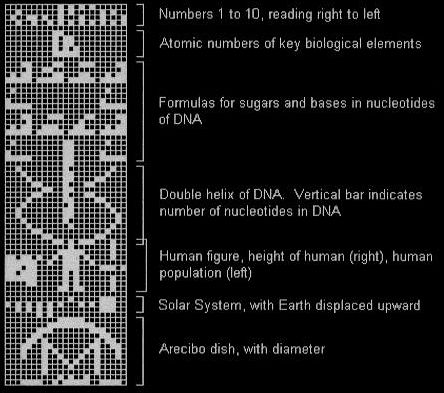Arecibo message

The Arecibo message was the first attempt at CETI; it consisted of a message beamed toward the star cluster M13 (the Great Cluster in Hercules) on 16 November 1974, by the Arecibo radio telescope. The signal, transmitted at 2380 megahertz with a duration of 169 seconds, delivered an effective power of 3 trillion watts, the strongest man-made signal ever sent.
A technique first suggested by Frank Drake (see Drake's cryptogram) was used to encode the message which consisted of a string of 1679 binary digits, or bits. An intelligent being striving to decipher the message, it is hoped, would eventually recognize that 1679 is a multiple of two prime numbers, 23 and 73 (see mathematics, as a universal language). Arranging the bits into 73 rows of 23 characters each and representing a zero by a blank space and a one by a solid space enables a meaningful picture to emerge. The top part of the message establishes that the number system to be used is binary. Under this appear the atomic numbers for the main biological elements, carbon, hydrogen, oxygen, nitrogen, and phosphorus, and the make-up of DNA. The rest of the message deals with the appearance, size, and number of human beings, our location within the solar system, and a description of the transmitting telescope. Following the announcement that the transmission had been made, a debate began (which continues to this day) on the wisdom of attempting CETI (see CETI, opposition).
On its 25,000-year-long journey, it is likely that the Arecibo message will be seriously degraded by its interaction with cosmic dust in the interstellar medium. Moreover, the loss of even a few bits of information would render the signal undecipherable. To address this problem, a much larger message has recently been broadcast which contains data duplicated in such a way that the loss of some parts of the transmission need not result in a total loss of meaning (Encounter 2001 Message).


